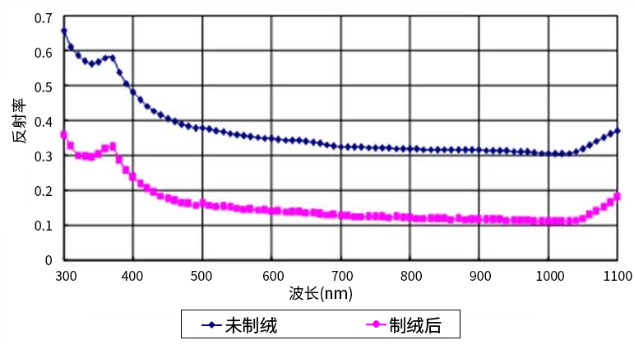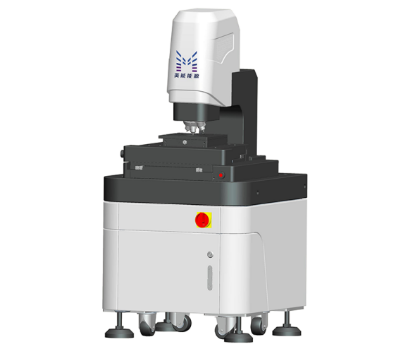
量子效率测试仪
PL/EL一体机
Sinton硅片少子寿命测试仪
Sinton硅块少子寿命测试仪
绒面反射率测试仪
3D共聚焦显微镜
清洗制绒工作站
在线四探针方阻测试仪
全自动扫描四探针方阻测试仪
在线薄膜厚度测试仪
晶化率测试仪
Horiba显微共焦拉曼光谱仪
傅里叶红外光谱仪
霍尔效应测试仪
分光光度计
全光谱椭偏仪
Horiba椭圆偏振光谱仪
TLM接触电阻率测试仪
超景深显微镜
网版智能影像测量仪
全自动影像测量仪
卧式拉力机
电池片稳态光衰老化试验箱
电池片紫外老化试验箱
电池片拉脱力综合测试仪
外观检验台
湿漏电测试系统
组件实验室EL测试仪
紫外老化试验箱
稳态光衰老化试验箱
电流连续性监测系统
PID测试系统
旁路二极管测试系统
LeTID测试系统
反向电流过载系统
脉冲电压测试系统
绝缘耐压测试仪
接地连续性测试仪
绝缘耐压接地测试仪
湿热环境试验箱
湿冻环境试验箱
热循环试验箱
动态机械载荷测试机
静态机械载荷测试机
冰雹冲击试验机
引出端强度试验机
霰弹冲击试验机
抗划伤(切割)测试机
剥离试验机
万能材料试验机(单臂)
万能材料试验机(双臂)
光伏玻璃透过率测试仪
醋酸测试试验箱
交联度测试系统
二极管接线盒综合测试仪
落球冲击试验机
半自动四探针
全自动探针式台阶仪
多通道太阳能MPPT系统
Horiba稳瞬态荧光光谱仪
钙钛矿P1激光划线测试仪
钙钛矿在线膜厚测试仪
钙钛矿工艺检测工作站
手持式IV测试仪
便携式EL测试仪
手持热成像测试仪
户外组件IV测试仪
户外组件多通道测试系统
光伏逆变器电能质量测试仪
无人机EL检测仪
单晶硅片制绒的影响因素
日期:2024-02-03浏览量:20
太阳能电池生产环节中,清洗制绒是重要的环节之一,制绒的工艺流程的优化和技术升级能提高太阳能电池的转换效率,降低生产成本。制绒绒面的形成受到NaOH的浓度、停留时间、过程中温度等等因素的影响。美能3D共聚焦显微镜,专为光伏行业而生,能够测量亚微米级的形貌起伏,可以手动亦可自动测量金字塔绒面的整体形状,单个金字塔的形状和高度也能高精度呈现,满足客户的测试需求。

硅片为何需要制绒?
首先清洗制绒这个环节可以去除硅片表面的污渍,降低不良品的出现。其次较好的金字塔,一定是小而均匀的,且布满整个硅片表面,这增加了硅片表面积,也意味着增加了PN结的面积。
最重要的是制绒可以形成起伏不平的绒面,使之产生陷光效应,增加硅片对太阳光的吸收,降低硅表面的光反射率,提高短路电流Isc,使光最大限度的被利用转化为电能。

单晶硅片制绒前后表面反射率
制绒的最佳效果
在合适的腐蚀速率下,成核与生长达到一个平衡,形成大小合适、结构完整且密布整个硅片表面的金字塔结构,此时的金字塔结构较为优化,减反效果最好。
如果腐蚀速率较高,金字塔的生长会大于成核,表现的绒面结构为大金字塔,且表面有未成核处,金字塔之间的空隙增大了表面反射率。当腐蚀速度过低时,金字塔成核大于生长,表现为结构不完整、密而层叠的金字塔。

腐蚀速率快慢由三个反应速度来决定,一是腐蚀液流至被腐蚀物表面的移动速率;二是腐蚀液与被腐蚀物表面产生化学反应的反应速率;三是生成物从被腐蚀物表面离开的速率。
制绒的影响因素
1. NaOH浓度影响
NaOH浓度对硅片反应速率有重要影响。制绒过程中,由于所用NaOH浓度均为低碱浓度,随NaOH浓度升高,硅片腐蚀速率相对上升。与此同时,随NaOH浓度改变,硅片反应的AF也发生改变,因此,NaOH浓度对金字塔的角锥度也有重要影响。

不同NaOH浓度下的绒面显微镜图
2. 温度影响
温度过高,反应AF值下降,绒面连续性降低,同时腐蚀速率过快,控制困难;
温度过低,则腐蚀速率过慢,制绒周期延长,通常制绒温度控制在75℃-85℃。

不同温度下的绒面显微图
3. 时间影响
制绒包括金字塔的形核及长大过程,因此制绒时间对绒面的形貌及硅片腐蚀量均有重要影响,下图为不同制绒时间后绒面显微情况;

不同制绒时间的绒面显微图
经热的浓度的碱去除损伤层后,硅片表面留下了许多肤浅的准方形的腐蚀坑;
经热的低浓度碱的制绒液中:
1min后,金字塔如雨后春笋,零星的冒出头;
5min后,硅片表面基本被小金字塔覆盖,少数已开始长大,我们称绒面初期的这种变化为金字塔成核;
10min后,金字塔密布的绒面已经形成,只是大小不均匀,反射率也降低到比较低的水平;
随着时间的延长,金字塔向外扩张兼并,体积逐渐膨胀,尺寸趋于均匀,时间过长绒面结构均匀性反而下降。
美能3D显微镜

美能3D共聚焦显微镜是以光学技术为原理、结合精密Z向扫描模块、3D建模算法等对器件表面进行非接触式扫描并建立表面3D图像,通过系统软件对栅线的高度与宽度、绒面上的金字塔数量进行定量检测,以反馈其中的清洗制绒、丝网印刷工艺质量。
精确可靠的3D测量,实现实时共聚焦显微图像
超高共聚焦镜头,Z轴显示分辨率可达1nm
198-39966倍最大综合倍率,精确测量亚微米级形貌
全自动栅线绒面测量,快速生成数据
ME-PT3000 3D共聚焦显微镜专用于光伏行业对光伏电池片表面的栅线及绒面进行质量检测的光学仪器。以光学技术为原理、结合精密Z向扫描模块、3D建模算法等对器件表面进行非接触式扫描并建立表面3D图像,通过系统软件对光伏电池片上的栅线的高度与宽度、绒面上的金字塔数量进行定量检测,以反馈光伏电池片清洗制绒、丝网印刷工艺质量。




































































